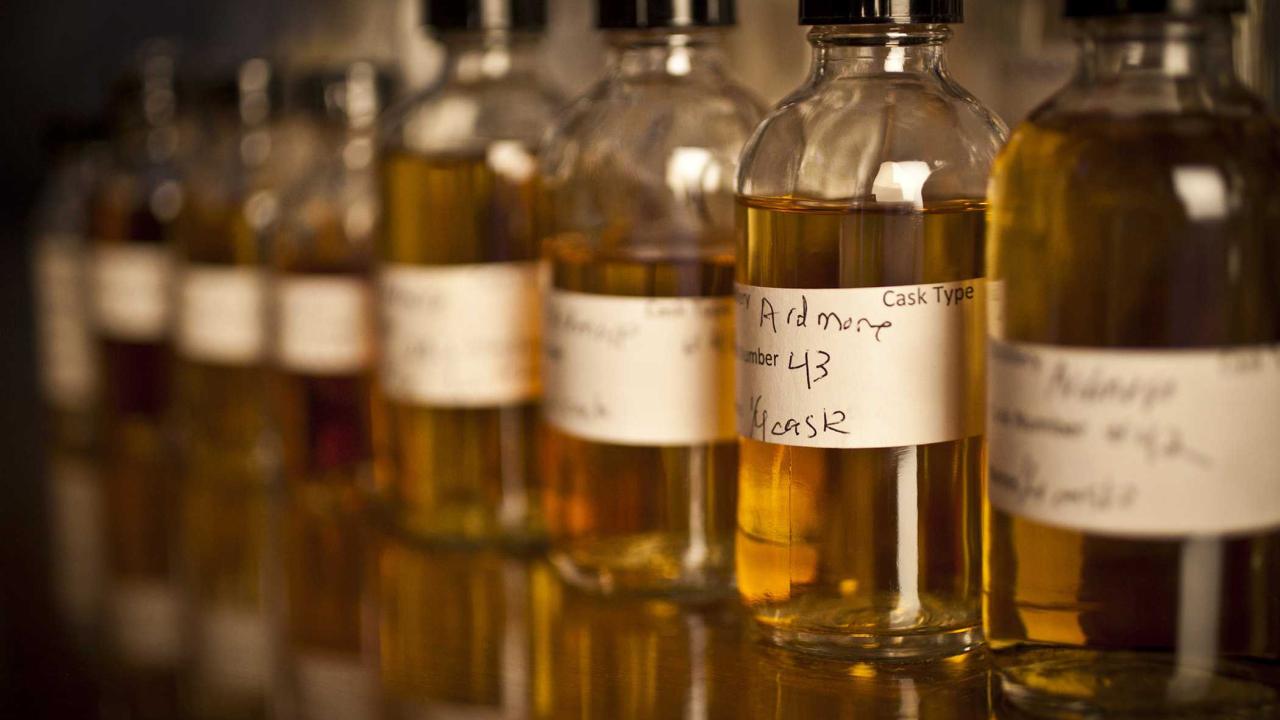Next auction starts Friday 27 June. Ready to sell your whisky? Sell with us in our next auction
Discover and bid on old, rare and collectible whiskies in our online auctions each month.

Functioning as a tangible library of bottles, the scope and breadth of Pat’s Whisk(e)y collection provides us with unique opportunities to explore the themes and stories within not just it, but the history of the spirit itself. One of these, and the subject of our third specialist auction from Pat’s Whisk(e)y is blends, and specifically the flagbearers for the 21st century revival of the category, Compass Box.
Despite brands like Johnnie Walker, Ballantine’s and Chivas Regal still being Scotch whisky’s best-selling products, the blend has for many years been relegated to the status of the single malt category’s unfashionable cousin. This has not always been the case though. Blended Scotch quickly took off in popularity after being introduced by Andrew Usher of Edinburgh in the early 1860s, remaining the whisky of choice for over 100 years. Blended Scotch was initially attractive to distillers as it allowed cheaply produced grain whisky to be enhanced by the bolder flavours of single malt, then generally perceived to be too rough around the edges to be bottled on its own. It was the opinion of all but a select few that a blend was the best way to drink both.
This all changed in the early 1980s when a shift in the average palate saw the market preference switch to other spirits like vodka and rum. This was coupled by an emerging connoisseurial appreciation for single malt, which began to favour the nuance and intricacies that had previously been seen as its flaws. The movement had its strongest roots in Italy, but quickly spread domestically and across wider Europe as well. By this time, the biggest blends and the distilleries were mostly owned by several large companies, and they survived the era of oversupply by scaling back their operations and giving greater attention to their single malt whisky.
Independently owned distilleries like Glenfiddich and Macallan were the ones that hit the ground running, however the blending empires eventually found their feet. Most notably United Distillers and their introduction of the Classic Malts in 1988, which successfully relaunched single malt brands for its Lagavulin, Talisker, Oban, Dalwhinnie, Cragganmore and Glenkinchie distilleries. This was followed by similar packages from Allied Distillers (Laphroaig, Tormore, Miltonduff, Glendronach and later Scapa) called the Caledonian Malts, and the Heritage Selection from Seagram (Longmorn, Glen Keith, Strathisla and Benriach). By the time Compass Box was formed in 2000, the number of parent companies had contracted even further, and the collapsing Seagram about to be carved up between Diageo and Pernod-Ricard. Clearly, a new independent approach was the key to reviving the perception and popularity of the blend.
John Glaser, a former marketing director for Johnnie Walker recognised this, and Compass Box made early waves for its understanding that a rejuvenated attitude to blended whiskies lay in a forward-thinking approach rather than a misty-eyed romanticism of its 20th century heyday. To this end, the company set its stall out immediately, with its first release shunning malt whisky entirely. Hedonism, a provocative blend of two single grain whiskies was bottled for them by Gordon & MacPhail in October 2000. Hugely popular, the annual varying-batch release is still the company’s marquee product. Its first blended malt was bottled in 2001, and its twenty-year history to date has been strewn with increasingly sought-after and collectible whiskies, all of which are a testament to the company’s boundary pushing (and at times, crossing) approach to creating new whisky.
Although Pat’s Whisk(e)y collection features over 1000 bottles of blended Scotch whiskies, Compass Box comprises over 10% of these and it is clear why their output caught his imagination. When you consider Pat’s Trinity of Collectability: “liquid quality, the presentation, artwork and packaging and an interesting or unique concept behind each,” Compass Box delivers in spades. Crucially however, it also offers a fourth key element, transparency. We have already well-documented Pat’s love-affair with bourbon, in which the search for the truth about what is in each bottle is an un-ending but enjoyable quest. Compass Box, born into a world that better than ever understands its whisky, knows that transparency in the make-up of its blends adds a whole new dimension to our experience of them. Readily offering just such information, Compass Box is a collector and connoisseur’s dream. Not only does the provision of its recipes allow a deeper engagement with its whisky, but they highlight its freedom as an independent bottler and the diversity of expression that this brings. While Johnnie Walker and Ballantine’s are confined by the portfolios of their ownership, Compass Box can experiment with components from each, and does. Pat’s Whisk(e)y, as we have often said, is more than just a collection. It was a journey of discovery, and as long as even just one more person shares this approach, Compass Box will always be along for the ride.
Discover and bid on old, rare and collectible whiskies in our online auctions each month.
Our global whisky auctions give your bottles the attention they deserve. Get started with a free valuation today.